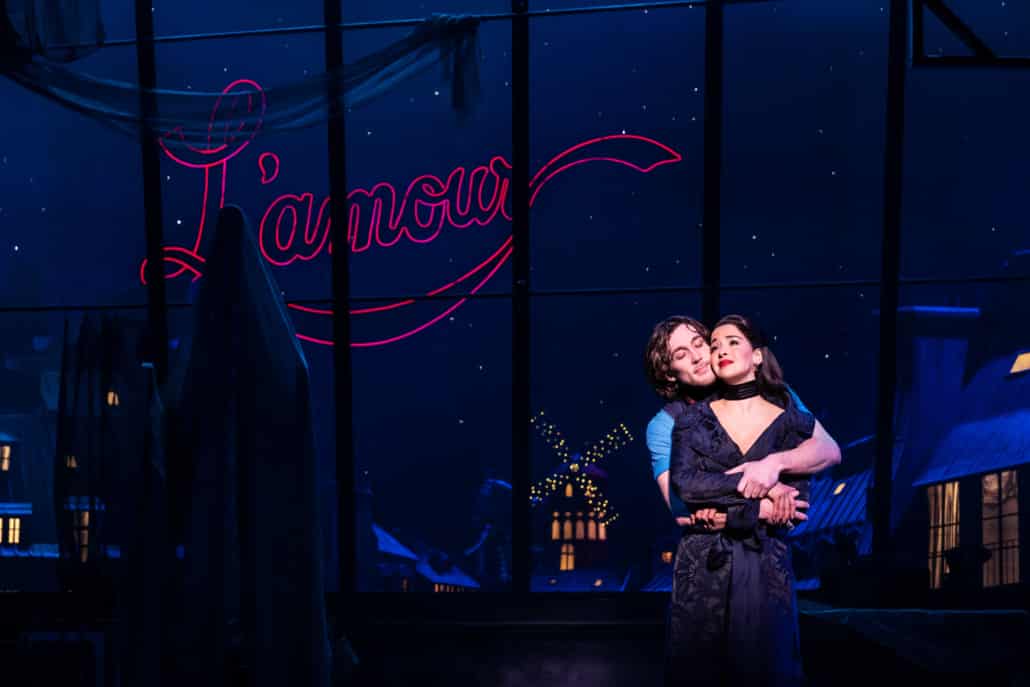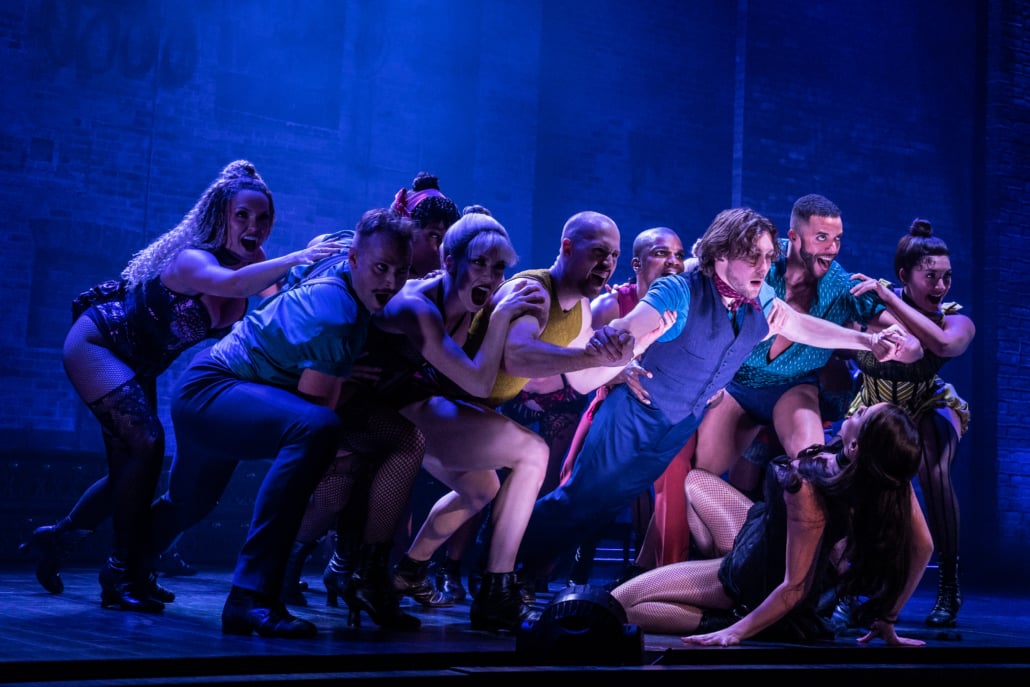DCPA NEWS CENTER
Enjoy the best stories and perspectives from the theatre world today.
Enjoy the best stories and perspectives from the theatre world today.
Originally published in 2022.
In 1889, two remarkable institutions that became synonymous with The City of Light opened.
One was the Eiffel Tower, a sky-scraping thousand-foot tall, wrought-iron structure erected for the Paris World’s Fair. It remains one of the most visited tourist attractions in the world.

Adéa Michelle Sessoms and Jennifer Wolfe in the North American Tour of Moulin Rouge! The Musical, Photo by Matthew Murphy for MurphyMade
The other? A scarlet-colored night spot with a distinctive windmill perched on its roof. Set in the Jardin du Paris, at the foot of the bohemian Montmartre district (where there were once many farms with windmills), the legendary Moulin Rouge (Red Mill) was created as a unique pleasure palace. There, the champagne flowed, the ornate décor beguiled, aristocrats and bohemian writers and artists mingled, and staged shows were opulent, risqué and at times scandalous.
A temple of decadence and dazzle, portrayed in the famed artworks of Henri de Toulouse-Lautrec, silent films and talkies, and most recently in a smash hit Broadway musical, the Moulin Rouge has persisted despite fires, wars, boom, bust, and two global pandemics.
Broadway’s Moulin Rouge! The Musical, the recipient of ten 2021 Tony Awards (including Best Musical) is currently spreading its nostalgic brand of extravaganza and ooh-la-la to Denver and other major U.S. cities. (The show is also still running on Broadway, in Australia and in London’s West End.)
The production is the latest chapter in the epoch-spanning fascination with the fabled Paris showplace. Adapted from Baz Luhrmann’s inventive 2001 film, Moulin Rouge! The Musical in style and spectacle lives up to movie critic Roger Ebert’s description of the movie as “all color and music, sound and motion, kinetic energy, broad strokes, operatic excess.”

Conor Ryan as Christian and Courtney Reed as Satine in the North American Tour of Moulin Rouge! The Musical, Photo by Matthew Murphy for MurphyMade.
But what sets the stage, if you will, for the musical’s romantic and pop-song mashup about a young poet’s love affair with a beautiful Moulin Rouge cabaret star?
Let’s rewind back to those heady times in the Belle Epoch era, when Paris was giddy with relaxed morals and waning class rigidity, and a host of new show palaces became all the rage.
The Moulin Rouge is the best known, and most enduring. It sported crystal chandeliers, mirrored walls and a spacious dance floor for performers as well as patrons. As they sipped champagne, the audience watched exuberant variety revues with musical, comedic and acrobatic acts. But the most famous act by far, and a mainstay today, is “le can-can,” — the high kicking dance executed at a furious pace by a chorus line of limber, skirt-swishing young women.
The can-can, which grew out of the less racy quadrille partner dance, revealed enough black-stockinged female leg in public to be shocking to prim Parisians.
But if the effect was titillating, it was leavened with winking humor. The early Moulin Rouge star La Goulue (“The Gourmand”) would kick the top hats off men’s heads. And when she spotted Britain’s Prince of Wales (the future King Edward VII) in the audience, she cheekily called out, “Hey Wales! The champagne’s on you?”
La Goulue is one of the dancers immortalized in portraits and posters by Toulouse-Lautrec, a regular at the Moulin Rouge (and nearby brothels). But the kicking, cartwheeling can-can moves he portrayed could also be injurious to the performers — especially the leaping splits that ritually ended a number.

Gabe MartÍnez as Santiago and Libby Lloyd as Nini in the North American Tour of Moulin Rouge! The Musical, Photo by Matthew Murphy for MurphyMade
Though the Moulin Rouge had a laissez-faire ambience, some routines ignited outrage. For instance, in 1907 the writer-performer Colette kissed her lover, the Duchess of Mornay, onstage in an Egypt-themed routine. At a time when any public display of homosexuality was illicit, the show was promptly banned.
During World War I, the original Moulin Rouge burned down in a 1915 blaze. It was rebuilt in 1921, and soon booked such entertainers as Maurice Chevalier. The owners also installed a cinema, and starting in the 1920s Black American acts were booked, including Lew Leslie’s Black Birds and performers from Harlem’s Cotton Club.
The Moulin Rouge stayed open in World War II but courted controversy. In Germany-occupied Paris, the club became a favorite “recreational” hub for Hitler’s officers. The rising chanteuse Edith Piaf faced criticism for singing there, while also helping Jewish friends escape the Nazis.
In the 1950s, French and American stars like Lena Horne and Frank Sinatra performed at the Moulin Rouge. And the club’s centenary in 1989 was marked with a celebrity gala featuring such headliners as Ray Charles, Ella Fitzgerald and actress Jane Russell. While today Parisians tend to view it as mainly a tourist attraction, the Moulin Rouge continues to draw crowds to its dinner shows.

The cast of the North American Tour of Moulin Rouge! The Musical, Photo by Matthew Murphy for MurphyMade
Since the 1920s, French and Hollywood moviemakers have evoked the glittering past of the cabaret in more than a dozen films. The 1952 hit Moulin Rouge directed by John Huston focused on Jose Ferrer as Toulouse-Lautrec. The 1960 feature Can-Can, adapted from the Broadway musical about habitués of a club based on the Moulin Rouge, drew global attention when Russian leader Nikita Khrushchev visited the movie set.
In 2001, Luhrmann’s Moulin Rouge!, with its eye-popping visuals and ingenious postmodern pastiche of modern pop tunes, made a huge splash. And Luhrmann gave his blessing to the Broadway adaptation, serving as a “guide” and supporter for the musical.
Like its namesake, Moulin Rouge! The Musical has had staying power. In fact with its splashy scenic design, mash-up score of tunes by such pop favorites as Lady Gaga, Adele and Beyoncé, romantic panache and vibrant theatricality, it can serve as a sparkling diversion in a difficult era — a role that the Moulin Rouge itself has played for more than a century.
DETAILS
Moulin Rouge! The Musical
Aug 6-17, 2025 • Buell Theatre
Tickets
